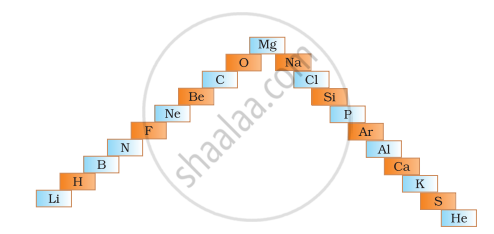Advertisements
Advertisements
प्रश्न
Write scientific reason.
Atomic radius goes on increasing down a group.
उत्तर
Atomic radius increases as we move from top to bottom in a group of the periodic table because a new shell of electrons is added to the atoms at every step. As the number of shells in the atoms increases gradually due to which the size of atoms also increases. As the size of the atoms increases which leads to an increase in the atomic radius of an atom.
APPEARS IN
संबंधित प्रश्न
Answer the following in respect of element `31/15 P `
Give its formula with chlorine?
Why is the size of sodium is greater than magnesium?
Which is greater in size an atom or an anion?
Size of atom progressively becomes smaller when we move from sodium (Na) to chlorine (CI) in the third period of the periodic table?
Fill in the blank:
On moving across a period from right to left in the periodic table, the atomic size of the atom ___________.
Write the name and symbol of the element from the description.
The atom having the smallest atomic mass.
Write the name and symbol of the element from the description.
The noble gas with the smallest atomic radius.
Give scientific reasons for the following:
Atomic radius goes on decreasing while going from left to right in a period.
What happens to the atomic size of elements on moving from left to right in a period?
With reference to the variation of properties in the Periodic Table, which of the following is generally true?
Atomic size increases from left to right across a period.
Write information about the given atomic numbers in the table. 10, 20, 7.
| Atomic Number | Electronic configuration | Group | Period | Element |
| 10 | ||||
| 20 | ||||
| 7 |
Which of the following is the correct order of atomic size?
Which among the following elements has the largest atomic radii?
Which of the following are the characteristics of isotopes of an element?
- Isotopes of an element have same atomic masses
- Isotopes of an element have same atomic number
- Isotopes of an element show same physical properties
- Isotopes of an element show same chemical properties
An element X (atomic number 17) reacts with an element Y (atomic number 20) to form a divalent halide.
- Where in the periodic table are elements X and Y placed?
- Classify X and Y as metal (s), non-metal (s) or metalloid (s)
- What will be the nature of oxide of element Y? Identify the nature of bonding in the compound formed
- Draw the electron dot structure of the divalent halide
Atomic number of a few elements are given below
10, 20, 7, 14
- Identify the elements
- Identify the Group number of these elements in the Periodic Table
- Identify the Periods of these elements in the Periodic Table
- What would be the electronic configuration for each of these elements?
- Determine the valency of these elements
- In below ladder symbols of elements are jumbled up. Rearrange these symbols of elements in the increasing order of their atomic number in the Periodic Table.
- Arrange them in the order of their group also.

An element with the largest atomic radius among the following is ______.
Give reason for the following:
The size of a Cl− ion is greater than the size of a Cl atom.
